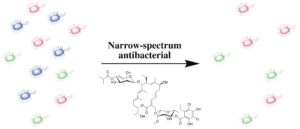Multidrug Resistant Bacterial Pathogens
Antibiotic resistance is one of the greatest threats to human health facing the world today. The rise in multi-drug resistant bacterial pathogens threatens the vast medical advancements made possible by antibiotics over the last 70+ years. Surgery, premature infant care, cancer chemotherapy, care of the critically ill, and transplantation medicine to name a few fields are feasible only with the existence of effective antibiotic therapy. The Melander lab is currently pursing several approaches to tackling this problem.
Antibiotic Adjuvants
One approach utilizes antibiotic adjuvants; small molecules that target resistance mechanisms and render bacteria susceptible to currently approved antibiotics.
We use a phenotypic screening approach coupled with medicinal chemistry to identify and optimize compounds that mitigate acquired resistance to various antibiotic classes against a diverse spectrum of bacterial strains.
We utilize a variety of biochemical and genetic methods to investigate the mechanisms of action of lead compounds including: pull-down assays with labelled compounds, screening of mutant libraries, quantification of RNA and protein expression levels, analysis of the composition of the bacterial cell wall and membrane, analysis of cell permeability and compound efflux, and analysis of enzymatic activity.
Melander, R.J. and Melander, C. The Challenge of Overcoming Antibiotic Resistance: An Adjuvant Approach. ACS Infectious Diseases, 2017, 3, 559-563. doi.org/10.1021/acsinfecdis.7b00071
Melander, R.J., and Melander, C. Antibiotic Adjuvants. Topics in Medicinal Chemistry: Antibacterials (Springer). 2017, 25, 89-118. doi.org/10.1007/7355_2017_10
Reversing Acquired Resistance
Bacteria acquire resistance to antibiotics through a number of mechanisms, these include: antibiotic modification, target modification, efflux, and decreased antibiotic uptake. Additionally the pathways that activate and regulate these resistance mechanisms represent a target for enhancing antibiotic activity.

Examples of adjuvant mechanisms of action and discovery: (A) inhibition of antibiotic modification; (B) inhibition of target modification; (C) inhibition of efflux; (D) enhancement of antibiotic uptake; (E) inhibition of signaling pathways that mediate antibiotic resistance; (F) inhibition of biofilm formation, which leads to increased antibiotic tolerance; (G) target-blind whole cell screening of previously approved drugs for adjuvant activity.
Applications for which we have identified active compounds include:
- Suppression of ß-lactam resistance in Gram-positive and Gram-negative bacteria.
Brackett, C.M., Melander, R.J., An, I.H., Krisnamurthy, A., Thompson, R.J., Cavanagh, J., and Melander, C. Small Molecule Suppression of ß-Lactam Resistance in Multi-drug Resistant Gram-negative Pathogens. Journal of Medicinal Chemistry, 2014, 57 (17), 7450-7458. doi.org/10.1021/jm501050e
Harris, T.L., Worthington, R.J., and Melander, C. Potent Small Molecule Suppression of Oxacillin Resistance in methicillin-resistant Staphylococcus aureus. Angewandte Chemie, 2012, 51 (45), 11254-11257. doi.org/10.1002/anie.201206911
- Reversal of chromosomally encoded and plasmid (mcr-1) mediated colistin resistance in Gram-negative bacteria.
Barker, W. T., Jania, L. A., Melander, R. J., Koller, B. H., and Melander, C. Eukaryotic Phosphatase Inhibitors Enhance Colistin Efficacy in Gram-negative Bacteria. Chemical Biology & Drug Design. doi.org/10.1111/cbdd.13735
Nemeth, A. M., Basak, A. K., Weig, A. W., Marrujo, S. A., Barker, W. T., Jania, L. A., Hendricks, T. A., Sullivan, A. E., O’Connor, P. M., Melander, R. J., Koller, B. H., and Melander. C. Structure Function Studies on IMD-0354 Identifies Highly Active Colistin Adjuvants. ChemMedChem. 2020, 15 (2) 210-218 doi.org/10.1002/cmdc.201900560
Barker, W. T., Nemeth, A. M., Brackett, S. M., Basak, A. K., Chandler, C. E., Jania, L. A., Zuercher, W. J., Melander, R. J., Koller, B. H., Ernst, R. K. and Melander, C. Repurposing Eukaryotic Kinase Inhibitors as Colistin Adjuvants in Gram-negative Bacteria. ACS Infectious Diseases, 2019, 5, (10), 1764-1771 doi.org/10.1021/acsinfecdis.9b00212
Expanding the Spectrum of Known Antibiotics
Another application is expanding the spectrum of currently used antibiotics by overcoming intrinsic resistance mechanisms.
Examples include:
- Enhancing the activity of typically Gram-positive selective antibiotics such as macrolides and glycopeptides against Gram-negative bacteria.
Martin, S.E., Melander, R.J., Brackett, C.M., Scott, A.J., Chandler, C.E., Nguyen, C.M., Minrovic, B.M., Harrill, S.E., Ernst. R.K., Manoil, C., and Melander, C. Small Molecule Potentiation of Gram-positive Selective Antibiotics Against Acinetobacter baumannii. ACS Infectious Diseases, 2019, 5, (7), 1223-1230 doi.org/10.1021/acsinfecdis.9b00067
Hubble, V.B., Hubbard, B., Minrovic, B.M., Melander, R.J., and Melander, C. Using Small Molecule Adjuvants to Repurpose Azithromycin for Use Against Pseudomonas aeruginosa. ACS Infectious Diseases, 2019, 5 (1), 141-151. doi.org/10.1021/acsinfecdis.8b00288
- Rendering mycobacteria susceptible to ß-lactam antibiotics
Nguyen, T.V., Blackledge, M.S., Lindsey, E.A., Minrovic, B.M., Ackart, D.F., Jeon, A.B., Obregon-Henao, A., Melander, R.J., Basaraba, R.J., and Melander, C. The Discovery of 2-Aminobenzimidazoles that Sensitize M. smegmatis and M. tuberculosis to ß-Lactam Antibiotics in a Pattern Distinct from ß-Lactamase Inhibitors. Angewandte Chemie, 2017, 56 (14), 3940-3944. doi.org/10.1002/anie.201612006
Jeon, A.B., Obregon-Henao, A., Ackart, D.F., Podell, B.K., Belardinelli, J., Jackson, M., Nguyen, T.V., Blackledge, M.S., Melander, R.J., Melander, C., Johnson, B., Abramovitch, R., and Basaraba, R.J. 2-Aminoimidazoles Potentiate ß-Lactam Antimicrobial Activity against Mycobacterium tuberculosis by Reducing ß-Lactamase Secretion and Increasing Cell Wall Permeability. PLOS One, 2017, 12, e0180925. doi.org/10.1371/journal.pone.0180925
We are also investigating compounds that further enhance the sensitivity of antibiotics against susceptible strains. This has the potential to enable lower antibiotic dosing, which would lead to a reduction in unwanted side effects and potentially reduced rates of resistance evolution.
Minrovic, B.M., Jung, D., Melander, R.J., and Melander, C. A New Class of Adjuvants Enables Lower Dosing of Colistin Against Acinetobacter baumanii. ACS Infectious Diseases, 2018, 4 (9), 1368-1376. doi.org/10.1021/acsinfecdis.8b00103
Suppressing antibiotic tolerance
In addition to genotypic antibiotic resistance mechanisms, bacterial tolerance is another phenomenon for which adjuvants can be utilized. Bacteria can exhibit phenotypes that impart increased tolerance to both antibiotics and host immune responses. Examples of such phenotypes include the adoption of a persister state, and the formation of biofilms.
Biofilms are defined as a surface attached community of bacteria encased in an extracellular matrix. Bacteria within a biofilm are typically 100-1000-fold more resistant to antibiotics than planktonic bacteria,and are recalcitrant to clearance by the host immune response.
Anti-biofilm agents have the potential to enhance the efficacy of antibiotics for the treatment of numerous infections including: infections of IMD, chronic wound infections and lung infections in cystic fibrosis patients.

Melander, R.J., and Melander, C. Strategies for the Eradication of Biofilm-Based Bacterial Infections. Antibacterial Drug Discovery to Combat MDR. (Springer) 2019, 499-526 doi.org/10.1007/978-981-13-9871-1_22
Melander, R. J., Basak, A. K., and Melander, C. Natural Products as Inspiration for the Development of Bacterial Antibiofilm Agents. Natural Product Reports. doi.org/10.1039/D0NP00022A
To address this problem, we are investigating the effects that simple structural motifs found embedded in complex marine natural products have upon biofilm development and maintenance. We have demonstrated that simple derivatives of marine alkaloid natural products inhibit and disperse biofilms from pathogenic Gram-negative, Gram-positive, and mycobacteria as well as fungi, and mixed species biofilms.
Brackett, S. M., Cox, K. E., Barlock, S. L., Huggins, W. M., Ackart, D. F., Bassaraba, R. J., Melander, R. J., and Melander, C. Meridianin D Analogues Possess Antibiofilm Activity Against Mycobacterium smegmatis. RSC Medicinal Chemistry. 2020, 11, 92-97 doi.org/10.1039/C9MD00466A
Huggins, W.M., Nguyen, T.V., Hahn, N.A., Baker, J.T., Kuo, L.G., Kaur, D., Melander, R.J., Gunn, J.S., and Melander, C. 2-Aminobenzimidazoles as Antibiofilm Agents Against Salmonella eterica Serovar Typhimurium. MedChemComm, 2018, 9 (9), 1547-1522. doi.org/10.1039/c8md00298c
Huggins, W.M., Barker, W.T., Baker, J.T., Hahn, N., Melander, R.J., and Melander, C. Meridianin D Analogues Display Antibiofilm Activity Against MRSA and Increase Colistin Efficacy in Gram-Negative Bacteria. ACS Medicinal Chemistry Letters, 2018, 9 (7), 702-707 doi.org/10.1021/acsmedchemlett.8b00161
Narrow Spectrum Antibiotics
Another avenue we are pursuing focuses on developing that possess narrow spectrum antibiotic profiles, and thus potentially less damaging to commensal flora, and less susceptible to resistance evolution.
Melander, R.J., Zurawski, D.V., and Melander, C. Narrow-Spectrum Antibacterial Agents. MedChemComm, 2018, 9, 12-21. doi.org/10.1039/C7MD00528H

Huggins. W.M., Minrovic, B.M., Corey, B.W., Jacobs, A.C., Melander, R.J., Zurawski, D.V., and Melander, C. 1,2,4-Triazolidine-3-thiones as Narrow Spectrum Antibiotics Against Multi-Drug Resistant Acinetobacter baumannii. ACS Medicinal Chemistry Letters, 2017, 8 (1), 27-31. doi.org/10.1021/acsmedchemlett.6b00296
Collaborators
John Cavanagh – East Carolina University
Robert Ernst – University of Maryland, Baltimore
Colin Manoil – University of Washington
Randall Basaraba – Colorado State University
Beverly Koller – University of North Carolina at Chapel Hill
Hui Wu – Oregon Health & Science University
Cassandra Quave – Emory University
John Gunn – The Ohio State University
Alex Horswill – University of Colorado School of Medicine

